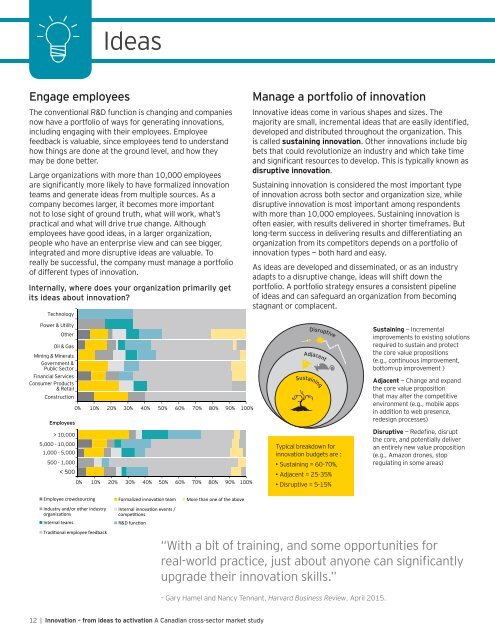Innovation from ideation to activation
Innovation-from-ideation-to-activation
Innovation-from-ideation-to-activation
Create successful ePaper yourself
Turn your PDF publications into a flip-book with our unique Google optimized e-Paper software.
Ideas<br />
Engage employees<br />
The conventional R&D function is changing and companies<br />
now have a portfolio of ways for generating innovations,<br />
including engaging with their employees. Employee<br />
feedback is valuable, since employees tend <strong>to</strong> understand<br />
how things are done at the ground level, and how they<br />
may be done better.<br />
Large organizations with more than 10,000 employees<br />
are significantly more likely <strong>to</strong> have formalized innovation<br />
teams and generate ideas <strong>from</strong> multiple sources. As a<br />
company becomes larger, it becomes more important<br />
not <strong>to</strong> lose sight of ground truth, what will work, what’s<br />
practical and what will drive true change. Although<br />
employees have good ideas, in a larger organization,<br />
people who have an enterprise view and can see bigger,<br />
integrated and more disruptive ideas are valuable. To<br />
really be successful, the company must manage a portfolio<br />
of different types of innovation.<br />
Internally, where does your organization primarily get<br />
its ideas about innovation?<br />
Technology<br />
Manage a portfolio of innovation<br />
Innovative ideas come in various shapes and sizes. The<br />
majority are small, incremental ideas that are easily identified,<br />
developed and distributed throughout the organization. This<br />
is called sustaining innovation. Other innovations include big<br />
bets that could revolutionize an industry and which take time<br />
and significant resources <strong>to</strong> develop. This is typically known as<br />
disruptive innovation.<br />
Sustaining innovation is considered the most important type<br />
of innovation across both sec<strong>to</strong>r and organization size, while<br />
disruptive innovation is most important among respondents<br />
with more than 10,000 employees. Sustaining innovation is<br />
often easier, with results delivered in shorter timeframes. But<br />
long-term success in delivering results and differentiating an<br />
organization <strong>from</strong> its competi<strong>to</strong>rs depends on a portfolio of<br />
innovation types — both hard and easy.<br />
As ideas are developed and disseminated, or as an industry<br />
adapts <strong>to</strong> a disruptive change, ideas will shift down the<br />
portfolio. A portfolio strategy ensures a consistent pipeline<br />
of ideas and can safeguard an organization <strong>from</strong> becoming<br />
stagnant or complacent.<br />
Power & Utility<br />
Other<br />
Oil & Gas<br />
Mining & Minerals<br />
Government &<br />
Public Sec<strong>to</strong>r<br />
Financial Services<br />
Consumer Products<br />
& Retail<br />
Construction<br />
Employees<br />
> 10,000<br />
5,000 - 10,000<br />
1,000 - 5,000<br />
500 - 1,000<br />
< 500<br />
0% 10% 20% 30% 40% 50% 60% 70% 80% 90% 100%<br />
0% 10% 20% 30% 40% 50% 60% 70% 80% 90% 100%<br />
Sustaining<br />
Disruptive<br />
Adjacent<br />
Typical breakdown for<br />
innovation budgets are :<br />
• Sustaining = 60-70%,<br />
• Adjacent = 25-35%<br />
• Disruptive = 5-15%<br />
Sustaining — Incremental<br />
improvements <strong>to</strong> existing solutions<br />
required <strong>to</strong> sustain and protect<br />
the core value propositions<br />
(e.g., continuous improvement,<br />
bot<strong>to</strong>m-up improvement )<br />
Adjacent — Change and expand<br />
the core value proposition<br />
that may alter the competitive<br />
environment (e.g., mobile apps<br />
in addition <strong>to</strong> web presence,<br />
redesign processes)<br />
Disruptive — Redefine, disrupt<br />
the core, and potentially deliver<br />
an entirely new value proposition<br />
(e.g., Amazon drones, s<strong>to</strong>p<br />
regulating in some areas)<br />
Employee crowdsourcing<br />
Industry and/or other industry<br />
organizations<br />
Internal teams<br />
Traditional employee feedback<br />
Formalized innovation team<br />
Internal innovation events /<br />
competitions<br />
R&D function<br />
More than one of the above<br />
“With a bit of training, and some opportunities for<br />
real-world practice, just about anyone can significantly<br />
upgrade their innovation skills.”<br />
– Gary Hamel and Nancy Tennant, Harvard Business Review, April 2015.<br />
12 | <strong>Innovation</strong> – <strong>from</strong> ideas <strong>to</strong> <strong>activation</strong> A Canadian cross-sec<strong>to</strong>r market study


